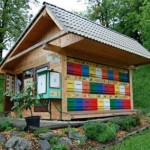How To Make Liquid Fertilizer For Houseplants At Home: Recipes for a Plant-Powered Dinner
Maintaining healthy houseplants requires providing them with the necessary nutrients for growth and vitality. While commercially produced fertilizers are readily available, creating liquid fertilizer at home offers a cost-effective and environmentally conscious alternative. Homemade liquid fertilizers utilize readily available organic materials, effectively transforming kitchen scraps and garden waste into plant food. The “dinner” aspect of the keyword refers metaphorically to providing plants with a nourishing meal to support their health and growth, similar to how dinner provides sustenance for humans. This article details various methods for creating homemade liquid fertilizers, providing recipes and guidance on their application to ensure thriving houseplants.
Understanding the Nutritional Needs of Houseplants
Houseplants, like all plants, require a balanced intake of macronutrients and micronutrients for optimal growth. Macronutrients, including nitrogen (N), phosphorus (P), and potassium (K), are essential for various plant functions. Nitrogen promotes leafy growth and overall vigor. Phosphorus supports root development, flowering, and fruiting. Potassium enhances disease resistance, water regulation, and overall plant health. Micronutrients, such as iron, manganese, zinc, copper, boron, and molybdenum, are needed in smaller quantities but are equally vital for enzymatic processes and overall plant development. Understanding these nutrient needs is crucial for selecting appropriate ingredients for homemade liquid fertilizers.
Deficiencies in these nutrients can manifest in various ways. Nitrogen deficiency can lead to yellowing of older leaves. Phosphorus deficiency may cause stunted growth and purplish discoloration of leaves. Potassium deficiency can result in brown or yellow margins on leaves. Micronutrient deficiencies can present as interveinal chlorosis (yellowing between veins) or other specific symptoms depending on the deficient element. Recognizing these symptoms allows for targeted fertilization using homemade solutions rich in the lacking nutrient.
The N-P-K ratio of a fertilizer indicates the relative proportions of nitrogen, phosphorus, and potassium. For example, a fertilizer with an N-P-K ratio of 10-10-10 contains equal amounts of nitrogen, phosphorus, and potassium. Different plants and different stages of growth may require different N-P-K ratios. For example, leafy plants often benefit from fertilizers with a higher nitrogen content, whereas flowering plants may require a higher phosphorus content. When creating homemade fertilizers, consider the approximate N-P-K ratio of the ingredients used to tailor the fertilizer to the specific needs of the houseplants.
Recipes for Homemade Liquid Fertilizers
Several methods can be employed to create effective liquid fertilizers at home, utilizing common household and garden waste products. Each recipe offers a different nutrient profile, catering to the diverse needs of houseplants. The following are some popular and effective recipes:
Compost Tea
Compost tea is a nutrient-rich liquid extracted from compost, providing a wide range of beneficial microorganisms and nutrients to plants. To make compost tea, place a generous scoop of well-rotted compost into a porous bag, such as cheesecloth or a burlap sack. Submerge the bag in a bucket of dechlorinated water. Aerate the mixture by using an aquarium air pump and airstone or by stirring it regularly for 24-48 hours. The aeration process encourages the growth of beneficial bacteria and fungi. After brewing, the liquid will have a tea-like color. Dilute the compost tea with water to a ratio of 1:10 before applying it to houseplants. Use as a soil drench or foliar spray.
The quality of compost tea depends heavily on the quality of the compost used. Opt for compost that is well-decomposed and free from pathogens. Different types of compost, such as vermicompost (worm castings) or leaf mold compost, will yield compost tea with varying nutrient profiles. Compost tea is generally rich in nitrogen, phosphorus, potassium, and micronutrients, making it a balanced fertilizer for various houseplants. However, it's crucial to avoid brewing compost tea in anaerobic (oxygen-deprived) conditions, as this can promote the growth of harmful bacteria.
Banana Peel Fertilizer
Banana peels are a rich source of potassium, an essential nutrient for flowering plants and overall plant health. To create banana peel fertilizer, several methods can be used. One method involves placing banana peels in a jar of water and allowing them to steep for several days. This process extracts potassium and other nutrients into the water. After a few days, remove the banana peels and use the infused water to water houseplants. Another method involves burying small pieces of banana peel directly into the soil around the base of houseplants. As the banana peels decompose, they release potassium into the soil, which the plants can then absorb. A third method involves drying banana peels and grinding them into a powder. The powder can then be sprinkled around the base of plants or mixed with water to create a liquid fertilizer.
When using banana peels, it is important to use organic bananas to avoid introducing pesticides into the soil. The frequency of application depends on the plant's needs and the concentration of the fertilizer. For the steeped water method, watering once every two to four weeks is usually sufficient. For the buried banana peel method, replace the peels every few months. For the banana peel powder method, apply a small amount every month. Banana peel fertilizer is particularly beneficial for flowering plants such as orchids, African violets, and peace lilies.
Eggshell Fertilizer
Eggshells are primarily composed of calcium carbonate, which is beneficial for plant cell wall development and overall plant structure. To create eggshell fertilizer, thoroughly rinse eggshells and allow them to dry completely. Once dry, crush the eggshells into a fine powder using a blender or mortar and pestle. The powdered eggshells can be added directly to the soil around houseplants. As the eggshells decompose, they release calcium into the soil, which the plants can then absorb. Alternatively, the powdered eggshells can be steeped in water for several days to create a calcium-rich liquid fertilizer. This liquid fertilizer can then be used to water houseplants.
Eggshell fertilizer is particularly beneficial for plants that are prone to calcium deficiencies, such as tomatoes, peppers, and eggplants. However, it can also be used for houseplants to improve their overall health and vigor. The calcium content of eggshells can also help to balance the soil pH, making it more alkaline. The frequency of application depends on the plant's needs and the soil pH. For the powdered eggshell method, apply a small amount every month. For the steeped water method, watering once every two to four weeks is usually sufficient.
Used Coffee Grounds
Used coffee grounds are a source of nitrogen and other nutrients, as well as organic matter that improves soil structure. Coffee grounds are slightly acidic, making them suitable for acid-loving plants. To use coffee grounds as fertilizer, simply sprinkle a thin layer of used coffee grounds around the base of houseplants. Alternatively, coffee grounds can be steeped in water to create a liquid fertilizer. To do this, mix a small amount of coffee grounds with water and allow it to steep for several hours or overnight. Strain the mixture and use the liquid to water houseplants.
Coffee grounds are particularly beneficial for acid-loving plants such as azaleas, camellias, and rhododendrons. However, they can also be used for other houseplants. It is important to use used coffee grounds, as fresh coffee grounds are too acidic and can harm plants. The frequency of application depends on the plant's needs and the soil pH. For the direct application method, apply a thin layer of coffee grounds every month. For the steeped water method, watering once every two to four weeks is usually sufficient.
Wood Ash Fertilizer
Wood ash is rich in potassium and other minerals, such as calcium, magnesium, and phosphorus. It can be used as a soil amendment and fertilizer for houseplants. Wood ash is alkaline, so it should be used with caution, especially for acid-loving plants. To use wood ash as fertilizer, sprinkle a small amount around the base of houseplants, being careful to avoid direct contact with the plant stems. Alternatively, wood ash can be mixed with water to create a liquid fertilizer. To do this, mix a small amount of wood ash with water and allow it to settle. Carefully pour off the clear liquid and use it to water houseplants. Avoid using wood ash from treated wood, as it may contain harmful chemicals.
Wood ash is most beneficial for plants that prefer alkaline soil, such as clematis, lavender, and some vegetables. The frequency of application depends on the plant's needs and soil pH. Wood ash should be used sparingly, as excessive application can raise the soil pH to levels that are harmful to plants. Generally, application once or twice a year is sufficient. When using wood ash, it is essential to perform a soil test to determine the pH and nutrient levels before applying it to houseplants. This will help to avoid over-fertilization and ensure that the plants receive the appropriate nutrients.
Application Guidelines and Precautions
When using homemade liquid fertilizers, it is important to follow certain guidelines to ensure the safety and effectiveness of the fertilizer. The concentration of homemade fertilizers can vary depending on the ingredients used and the method of preparation. It is generally recommended to start with a diluted solution and gradually increase the concentration as needed. This helps to prevent over-fertilization, which can damage plants.
It is also important to water plants thoroughly before applying liquid fertilizer. This helps to prevent root burn, which can occur when fertilizer comes into direct contact with dry roots. Apply the fertilizer evenly to the soil around the base of the plant, avoiding direct contact with the plant stems and leaves. Allow the fertilizer to soak into the soil, and avoid overwatering. Monitor the plants for any signs of nutrient deficiencies or toxicity, such as yellowing leaves, stunted growth, or leaf burn. Adjust the frequency and concentration of fertilizer applications as needed.
When using homemade liquid fertilizers, it is essential to avoid using ingredients that may contain harmful chemicals or pathogens. For example, avoid using wood ash from treated wood, as it may contain chemicals that are toxic to plants. Also, avoid using compost that is not well-rotted, as it may contain pathogens that can cause plant diseases. Always use clean water when preparing liquid fertilizers, and avoid using water that is contaminated with chemicals or pollutants. Store homemade liquid fertilizers in a cool, dark place, away from direct sunlight and heat. This helps to prevent the growth of harmful bacteria and fungi.

10 Best Homemade Plant Fertilizers A Cultivated Nest

8 Organic Liquid Fertilizers You Can Make Feathers In The Woods

Make A Simple Organic Fertilizer For Healthy Indoor Plants Garden Therapy
:max_bytes(150000):strip_icc()/make-your-own-fertilizer-1388159-hero-025e07a9b96840568b5eb5050f4bab10.jpg?strip=all)
How To Make Your Own Fertilizer

Houseplant Fertilizer Free Homemade All Purpose Plant Food Sub Spanish

11 Diy Homemade Plant Fertilizers With Recipes Gardening

Top 10 Homemade Liquid Fertilizers Diy Plant Food That Will Transform Your Garden

11 Diy Homemade Plant Fertilizers With Recipes Gardening

Make A Simple Organic Fertilizer For Healthy Indoor Plants Garden Therapy

Make A Simple Organic Fertilizer For Healthy Indoor Plants Garden Therapy








